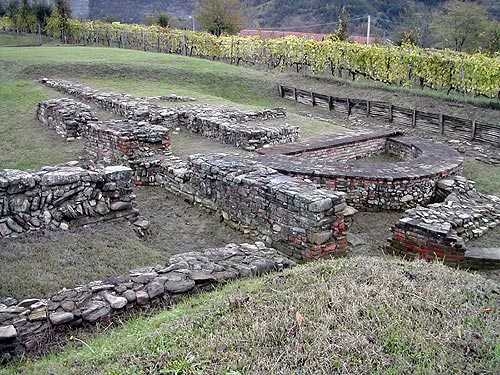

Archaeological site of the Roman city of Mevaniola, which has been excavated several times by the Archaeological Superintendence of Emilia – Romagna.
From the Roman city some structures of the public baths, the theater with its characteristic plan traceable to Greek-Hellenistic models and a small cistern are visible.
The remains of the Roman town of Mevaniola are located on a river terrace north of Borgo di Pianetto.
The archaeological area is bounded by the Rio Secco stream, from which come grave goods dated to the 6th century B.C., and the Catenacciano stream.
The Mevaniolense area was probably inhabited by Umbrian populations in pre-Roman times. The inclusion of the territories of Mevaniola and Sarsina, according to the testimony of Pliny the Elder, in the VI Augustan region of Umbria (instead of in the VIII Aemilia), together with the nearby centers of Forum Livi and Forum Popili, could be a proof of this. Very little is known about the Romanization and the early stages of the settlement.
However, the archaeological excavations that have been carried out revealed structures that mostly date back to the Late Republican period (1st century BC). The civic buildings found seem to have been organized around the small road that crosses the archaeological area and certainly traces the course of an important urban road (perhaps the Decumanus Maximus).
Walking up the small road, on the left, we find some structures that can be traced back to the public baths, partially excavated around the 1960s, of which a rectangular room with a semicircular structure (a basin?) can be seen today, perhaps part of the unheated area of the facility. From the excavations of the baths comes a mosaic inscription, now preserved in the ‘Mons. Domenico Mambrini’ Civic Museum, dates back to the middle of the 1st century B.C. and refers to the reconstruction of the aqueducts connecting to the baths.
In addition to the uniqueness of the writing technique, the mosaic is interesting because it testifies to the presence in Mevaniola of the gens Caesii, a family that held a prestigious place in many Umbrian municipalities (Mevania, Sassina, etc.) and that allows us to “follow the stages of the gradual process of Romanization of Italy” (F. Cenerini).
Northwest of the Baths (on the right of the small street) was the hypothetical forensic area (now buried) with a rectangular square (about 60 x 36.5 m) paved with sandstone tiles with inlays of red Verona marble. On a short side, to the east of the forum, there was probably a basilica with a rectangular plan (about 15 x 35 m).
A large key (length 24 cm) dated to the 1st century B.C., with an iron body and a bronze handle in the shape of a Molossian dog’s head, was found in an area north of the Forum during the 1951 excavation campaign, and is unique in Roman Italy.
Northwest of the Baths (on the right of the small street) was the hypothetical forensic area (now buried) with a rectangular square (about 60 x 36.5 m) paved with sandstone tiles with inlays of red Verona marble. On a short side, to the east of the forum, there was probably a basilica with a rectangular plan (about 15 x 35 m).
A large key (length 24 cm) dated to the 1st century B.C., with an iron body and a bronze handle in the shape of a Molossian dog’s head, was found in an area north of the Forum during the 1951 excavation campaign, and is unique in Roman Italy. In front of the Forum we find the Small Theatre (1st century B.C.), which follows the Greek-Hellenistic architectural model (full-circle orchestra tangent to the rectilinear stage, oblique side aisles), probably used for public meetings, given its proximity to the forensic area. Three tiers of bleachers remain in the Cavea today; the upper ones probably rested on an embankment or consisted of wooden structures.
In 1993 part of the town necropolis was excavated, the grave goods of which are displayed in the Mambrini Museum.
The name Mevaniola is reminiscent of ancient Mevania, now Bevagna in Umbria, but the relationship between the towns and the two place names is not yet clear.
Opening hours: Although the area is fenced, it can be visited at any time. Guided tours can be booked at the Cultural Office of the Municipality of Galeata.
Can’t find what you are looking for?
Have you found incorrect or missing content?
Send a feedback to the Tourist Information Office of the relevant Municipality. Go to the tourist offices page.